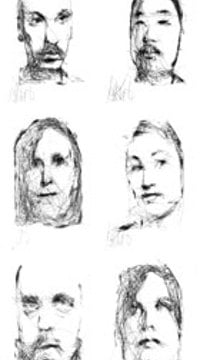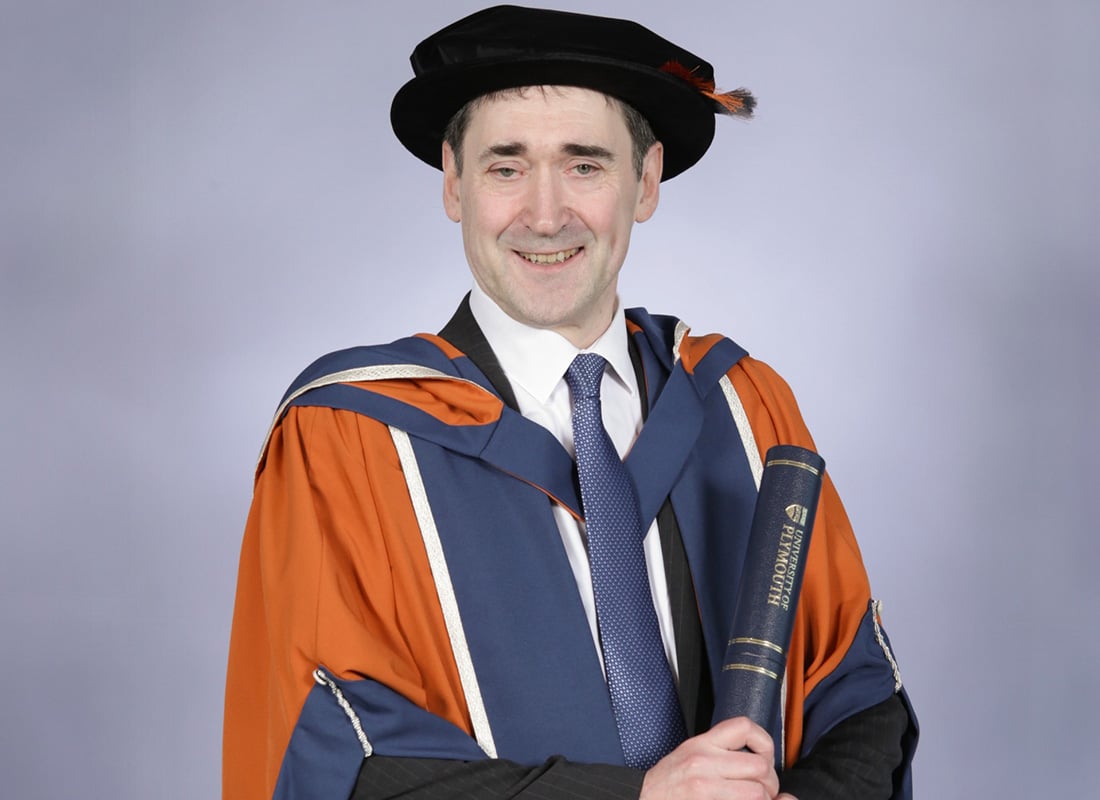 Click for larger image
Click for larger imageCredit: Patrick Tresset, Sketches by Paul (details), Biro on paper, 2011.
Copyright the artist, reproduced with permission.
In 1950 he devised the now famous ‘Turing Test’ for machine intelligence, posing the question ‘Can machines think?’ The question was discussed in the format of a game played by a man (A), a woman (B) and an interrogator (C) who puts questions to them in order to determine which is the man and which is the woman.
Turing asked what would happen when a machine took the part of A. He suggested that if the responses from the computer are indistinguishable from those of a human, then the computer can be said to be thinking. (For more see Alan Turing and his Contemporaries published by the BCS this year, p.16.)
This tantalising concept has captured the imagination of artists for decades whilst technological developments have given them the tools to create new kinds of artworks. One of the first artworks directly referencing the Turing Test was produced by American computer arts pioneer A. Michael Noll in the 1960s.
The so-called ‘Mondrian Experiment’ juxtaposed a black and white copy of Piet Mondrian’s abstract painting Composition with Lines (1917) and a variant created by a computer with a pseudo random number generator. A test audience was asked two questions: which one was made by Mondrian? Which one do you prefer?
According to Noll, 59 per cent of the subjects preferred the computer-generated picture and only 28 per cent correctly identified the work by Mondrian. This raised numerous questions, among them whether art could be made according to a set of instructions and could it be possible to program a computer to be an autonomous artist. It also heralded the beginning of the idea of art as a system that incorporates both the work and the spectator / participant as an integral element. These are now common factors in much digital artwork today.
A selection of contemporary artists inspired by Turing is featured in a fascinating exhibition entitled ‘Intuition and Ingenuity’ touring the country at present in celebration of Alan Turing Year 2012. It is co-curated by Anna Dumitriu, chair of the Computer Arts Society Nick Lambert and CAS committee member Sue Gollifer.
The artists are Roman Verostko, boredomresearch, Paul Brown (who has previously featured in this column), Ernest Edmonds, Gordana Novakovic, William Latham, Greg Garvey, Trope Troupe, Martin A Smith, Sue Gollifer, Anna Dumitriu, Alex May and our artist this month Patrick Tressent.
The exhibition is at the Victoria & Albert Museum this month as part of the V&A’s Digital Design Weekend - 22 and 23 September. This is a weekend of events celebrating contemporary digital art and design, including demonstrations of robotics, hacking and tinkering projects, interactive sound installations. Last year it attracted over 7,000 visitors, attesting to the increasing popularity of digital and media arts.
Patrick Tresset, a French artist / scientist currently based in London, uses what he calls ‘clumsy robotics’ to create autonomous cybernetic entities that are playful projections of the artist’s own mind and hand. He co-directs the Aikon-II project with Frederic Fol Leymarie at Goldsmiths College, University of London.
This project uses computational and robotic technologies to explore the human activity of drawing, which has been practiced in every civilisation for at least the last 30,000 years. Aikon’s main objective is to implement a computational system capable of simulating the various important processes involved in face sketching.
This will assist in gaining a better understanding of the emergence of style in observational sketches. The methodology deployed to shed light on this complex activity consists of developing a computational model of the processes at play during the sketching cycle.
Paul is a robotic entity that autonomously draws members of the public that sit in front of it in a style inspired by the artist’s own manner of sketching. It consists of a robotic arm and a camera with hardware and software designed and built by Patrick. It works by taking a photograph of the sitter then uses the same camera ‘eye’ to guide its drawing as it unfolds in front of the sitter (videos can be viewed on his website).
Patrick explains how Paul works, ‘I give Paul a signal to start by blinding him for ten seconds, after that he works on his own. First he looks for the sitter. When he finds the face of the person sitting in front of him, he focuses on it and scans it with successive saccades and fixations like a human eye would do.
Then the information is processed using Gabor filters that react like some of the cells in our early visual cortex, with this process salient lines are extracted and transformed into signals that are sent to the arm so it traces lines on the paper. This process is reiterated a number of times with the image at different scales.
Later, Paul performs shading of various tones based upon the light reflected on the sitter’s face. During this process Paul often looks at the sitter scanning the face again, alternatively, when he draws his eye follows the pen as a human would when they draw. When Paul has finished, he signs a signature, but I am still not sure what his last name is. What is surprising is that Paul draws like I used to when I was a painter.’
The work and the drawings have been exhibited all over the world and it is now on view at the V&A where Patrick will sometimes control the robot remotely, as a kind of artistic Turing Test - inviting audiences to guess which works are made by him and which autonomously by Paul. Why not go along and choose which version you prefer whilst pondering the questions: What is an artist? And who decides?
The exhibition ‘Intuition and Ingenuity’ will end its Alan Turing Year tour at Bletchley Park having been awarded Arts Council England funding to further develop and tour the show. As currently only about four per cent of the hundreds of organisations funded by the Arts Council are creating and producing digital content for a variety of platforms, attracting this funding is no small feat and the organisers are to be congratulated. A super little catalogue has been published too, see: http://turingcentenaryarts.tumblr.com/exhibition
See also the work in the V&A’s collection
Catherine Mason is the author of A Computer in the Art Room: the origins of British computer arts 1950-80, published in 2008.
More information on the Computer Arts Society, including our events programme












